| View previous topic :: View next topic |
| Author |
Message |
bob kerr

Joined: 13 Nov 2011
Posts: 638
Location: Monroeville PA



|
 Posted: Feb 20, 2015 17:34 Post subject: Re: Quartz, Natural and Synthetic Posted: Feb 20, 2015 17:34 Post subject: Re: Quartz, Natural and Synthetic |
|
|
here's a photo of the Colombian quartz specimen I bought at $200 a kg.
bob
| Mineral: | Quartz |
| Locality: | | Peñas Blancas Mine, Municipio San Pablo de Borbur, Western Emerald Belt, Boyacá Department, Colombia |  |
|
| Dimensions: | 8cm wide |
| Description: |
|
| Viewed: |
68888 Time(s) |
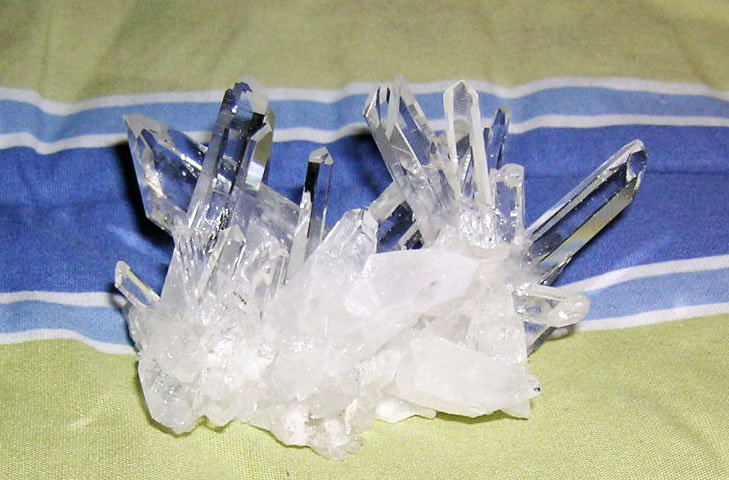
|
|
|
| Back to top |
|
 |
Fiebre Verde

Joined: 11 Sep 2013
Posts: 944
Location: Paris Area



|
 Posted: Feb 20, 2015 18:17 Post subject: Re: Quartz, Natural and Synthetic Posted: Feb 20, 2015 18:17 Post subject: Re: Quartz, Natural and Synthetic |
|
|
| bob kerr wrote: | here's a photo of the Columbian quartz specimen I bought at $200 a kg.
bob |
This is a stunning quartz.
When combined with emeralds, it becomes the holy grail of emerald matrix specimens.
Gérard
|
|
| Back to top |
|
 |
Pierre Joubert
Joined: 09 Mar 2012
Posts: 1605
Location: Western Cape



|
 Posted: Feb 21, 2015 03:48 Post subject: Re: Quartz, Natural and Synthetic Posted: Feb 21, 2015 03:48 Post subject: Re: Quartz, Natural and Synthetic |
|
|
Fantastic thread Elise! I have always wanted to acquire 'man made' quartz specimen/s and am glad to see that some one is selling them. Regards :-)
_________________
Pierre Joubert
'The tree of silence bears the fruit of peace. ' |
|
| Back to top |
|
 |
John S. White
Site Admin

Joined: 04 Sep 2006
Posts: 1298
Location: Stewartstown, Pennsylvania, USA



|
 Posted: Feb 21, 2015 06:23 Post subject: Re: Quartz, Natural and Synthetic Posted: Feb 21, 2015 06:23 Post subject: Re: Quartz, Natural and Synthetic |
|
|
I am one of those who found the repaired amethyst unsettling. It is all well and good to say it is okay if the specimens are appropriately labelled, but we all know that there are those who will not do so. In fact, I attended a small mineral show nearly two years ago where a dealer was selling very large sprays of the porcupine-like quartz, up to 10 inches or more, and they were not labelled as lab grown and he refused to tell potential buyers that they were not natural. But to return to the repaired amethyst, I would have been eager to examine it closely. One thing I have observed is that the striations on prism faces of lab grown quartz crystals are diagonal whereas those on natural quartz tend to be horizontal (at right angles to the prism edges). I would want to see if the striations on the repaired amethyst are diagonal or horizontal.
_________________
John S. White
aka Rondinaire |
|
| Back to top |
|
 |
Elise

Joined: 22 Dec 2009
Posts: 243
Location: New York State



|
 Posted: Feb 21, 2015 10:07 Post subject: Re: Quartz, Natural and Synthetic Posted: Feb 21, 2015 10:07 Post subject: Re: Quartz, Natural and Synthetic |
|
|
| John S. White wrote: | | One thing I have observed is that the striations on prism faces of lab grown quartz crystals are diagonal whereas those on natural quartz tend to be horizontal (at right angles to the prism edges). I would want to see if the striations on the repaired amethyst are diagonal or horizontal. |
For those wondering what John is referring to, here is a photo comparing the surface features of crystal faces on a synthetic specimen (old Russian grown crystal) and a natural quartz specimen. John has examined the one on the left, as has Si Frazier a couple years ago -- it's pretty neat. But, all depends on the seed crystal orientation and the growth conditions as to what appears to be a prism or other crystal face. It can be very disorienting without looking at the angles.
As to the repairing of specimens - isn't it done all the time with glue (?), especially with tourmaline? Well, maybe not a good analogy. I spent a lot of time trying to look at the amethyst cluster in the display - it was difficult to tell much about the angles and surface without good lighting while being able to turn it around in the hand -- I wondered how both changed in relation to the natural and whether there is overgrowth lower down that masks the natural part (also, how much color loss occurred and where - too bad it's not possible to capture on film what is happening inside the autoclave with time-lapse photography, such as can be done inside a Diamond Anvil Cell). But, I'd point out that the process is expensive and time consuming, not to mention dangerous. There is also the danger of damaging very expensive equipment. Rather than a link again, I'll paste in part of Jamison Brizendine's explanation for those who missed it (original: https://www.mineral-forum.com/message-board/viewtopic.php?p=43944&highlight=#43944):
| Jamison Brizendine wrote: |
Before the specimen was subjected to the autoclave, there were roughly seven crystals that probably were terminated. Most likely those crystals broke after the pocket was subjected to some tectonic force. One of the terminations later had secondary quartz crystal growth (lower front right). The quartz during the secondary quartz crystallization was clear as there was no iron to produce the amethyst color. Various smaller quartz crystals also grew during this secondary pulse of crystallization. One of the pre-requisites of trying to regrow quartz was that the amethyst had to have as little matrix as possible as the matrix would have dissolved, and then those dissolved particles would have damaged the steel autoclave. This particular specimen had barely any matrix and therefore made a very good candidate to attempt the experiment.
After five months of being in an alkaline aqueous solution at high temperature and pressure (roughly 650 F [345 C] and 10,000 psi), all broken terminations were “regrown and re-healed”. These new growths were all clear points, because the silica solution in the autoclave was pure. A small portion of synthetic quartz had to be added to the matrix to keep it stable and from breaking apart. The purple color has quite diminished, but there is still a portion of the original color that remained. Any small crystals originally on the matrix were dissolved in the autoclave. You can see the contact between new and old crystal growths quite easily. ..
(snip)....
To allay your fears about knowing the difference between synthetic vs natural quartz, you just have to look at the crystal very carefully. Often you can see the original seed quartz crystal in these clusters. It is also extremely difficult, laborious and requires intense knowledge, time and patience to regrow these clusters. Besides the waiting period, you need to maintain the correct temperatures and pressures, for months and even years at a time. If you make a mistake it can be catastrophic. Today, there are very few laboratories around the world that continue to even make synthetic quartz, because there are cheaper alternatives. So I doubt a lot of “copy cats” will pop up, but time will only tell.
|
The old lab-grown "mineral specimens" in my collection - quartz grown on druzy 40-50 years ago - are pretty weird looking if one looks closely. The angles are all off. I guess I'm more disturbed by the metaphysical hype surrounding quartz -- let's have more emphasis on learning about the crystallographic and other properties of minerals so that people will be better informed about what they are looking at....then they can inform the sellers promoting synthetic as natural or, in my mind, the much more disturbing notion of any "healing powers" of quartz (see: https://www.mineral-forum.com/message-board/viewtopic.php?p=33695&highlight=#33695 )
Carry on... ;-)
Elise
(PS: Pete - I would love to see that synthetic quartz cube!)
| Description: |
Synthetic and Natural Quartz
Photo: Elise Skalwold |
|
| Viewed: |
68835 Time(s) |
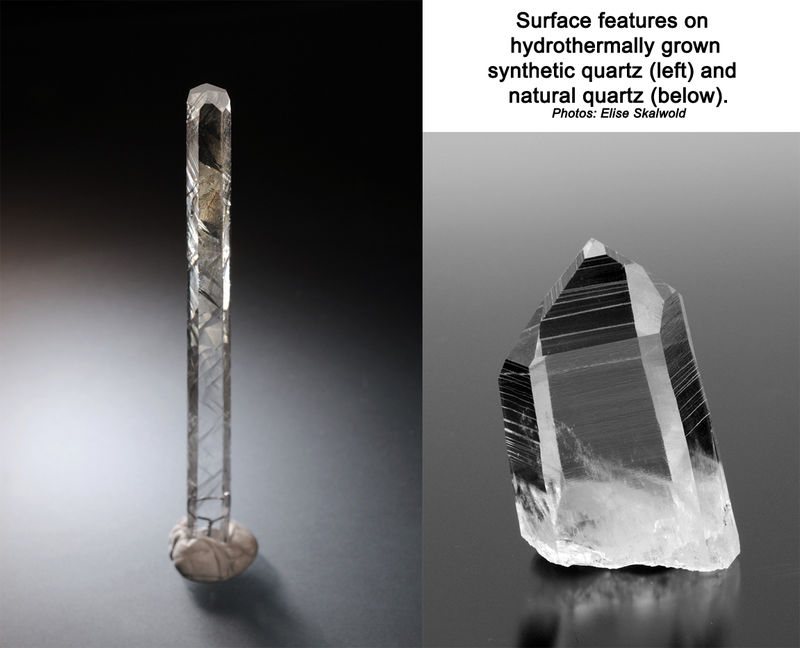
|
_________________
Elise Skalwold |
|
| Back to top |
|
 |
Elise

Joined: 22 Dec 2009
Posts: 243
Location: New York State



|
 Posted: Feb 23, 2015 15:45 Post subject: Re: Quartz, Natural and Synthetic Posted: Feb 23, 2015 15:45 Post subject: Re: Quartz, Natural and Synthetic |
|
|
| John S. White wrote: | | I am one of those who found the repaired amethyst unsettling. It is all well and good to say it is okay if the specimens are appropriately labelled, but we all know that there are those who will not do so. |
Our mutual friend mineralogist/gemologist John I. Koivula is finding our discussion very interesting and comments that any mineral which can be grown hydrothermally can also be repaired by regrowth - it is nothing new and has been done with emeralds to heal surface damage and cracks in crystals and gems (discussed and illustrated in his Photoatlas Volume 3 on pages 444 and 474).
_________________
Elise Skalwold |
|
| Back to top |
|
 |
lluis
Joined: 17 Nov 2006
Posts: 719


|
 Posted: Feb 23, 2015 16:08 Post subject: Re: Quartz, Natural and Synthetic Posted: Feb 23, 2015 16:08 Post subject: Re: Quartz, Natural and Synthetic |
|
|
Dear all
By sure, as Mr.White said, all that could be hydrothermally grown could be repaired. But as Mr. White said, do not label it is not exactly ethic in my understanding...
I have diamonds synthetic, and rubies, and a silver and a gold...
Three first sold me as synthetic. Last, as a palladium natural gold, that, things of live, has no palladium (tested) and is man made....and sold in Munich as man-made some years ago...
So, synthetics/man made are nice, no doubt. Just that this work in a honourable world....that, sadly, is not our world.... So many crooks selling synthetic as natural....
Repaired is repaired, cut is cut (some sold so, or so is said to me....), man made is man made... Just that not all those are properly labeled.
By the way, profit is great and not so difficult. Or not so difficult for me (chemist...).
Long time? Yes. But if you only need to wait.....
With best wishes
Lluis
|
|
| Back to top |
|
 |
Jamison Brizendine
Joined: 27 Feb 2014
Posts: 128
Location: Northeast Ohio



|
 Posted: Feb 24, 2015 17:17 Post subject: Re: Quartz, Natural and Synthetic Posted: Feb 24, 2015 17:17 Post subject: Re: Quartz, Natural and Synthetic |
|
|
Vladimir and I talked at our club meeting (Mineralogical Society of Cleveland) about his experiences at Tucson, people’s reaction to his case and some more of my observations.
I was aware of the upcoming article in Rocks & Minerals, but I withheld that information, because honestly….I wanted it to be a surprise. I haven’t seen the rough draft of it, but I will mention that it will come out before the end of 2016, probably very soon.
Vlad wanted me to let everyone know that the “Japan Law Twins” are not actual Japan Law twins; they are an attempt to making one. So far he has been unsuccessful at getting the correct angle needed for it be a Japan-law. Our club has dubbed them “Vlad Twins”, but yes these are some of my favorites too. It is still unclear what conditions are needed for a Japan-Law twin to actually occur in nature, and Vlad has never seen a Japan-Law Twin actually grow in the autoclave.
In Elise’s picture 20150220_Syn_Quartz_6613a96, you can see one of the seed crystals very easily, which actually is a very thin plate. It is running diagonally where the top crystals randomly generated across that plane.
In Elise’s picture 20150214_Tucson_6605a96, I believe the green inclusions in the twin are caused by loose acmite. I believe that is caused as a byproduct of the caustic solution and the steel autoclave.
My mother inquired if my specimen (the broken Guerrero), had won any awards. I explained to her that the quartz cases were non-competitive cases, but apparently if “Most scary!!” is an award, I guess it won that. Vlad told me that a lot of dealers (names withheld, but the majority whose names I had recognized) mentioned that they were “afraid”. Are we talking about fear as in walking in a haunted house with fake zombies covered in blood, that pop out at you of every crevice imaginable or fear as in my irrational fear of the leprechauns in “Darby O’Gill and the Little People”?
Wasn’t there, just last month, a thread about gypsum crystals, which I certainly wouldn’t term “natural” (https://www.mineral-forum.com/message-board/viewtopic.php?t=4083). I didn’t see comments that these would instill a new “Age of Fakery”, nor did I see comments that these gypsum clusters could evoke fear and terror into the hearts of mineral collectors. I have no doubt that John White’s example of his “Unscrupulous Mineral Dealer” would try to sell these gypsum crystals as natural ones too. There are just some dealers who will do anything dishonest to get a buck…
Again, I wanted to note here the only other successful attempt at “healing” a broken quartz was an heavily fractured Arkansas quartz. After about five months in the autoclave, the terminations did in fact “regrow”, but it didn’t “repair” or “fill” the fractures.
Vlad also has mentioned to me that any coatings on a crystal, like natural iron stained coatings or those weird looking “Aqua Aura Quartzes” would dissolve in an autoclave. I was massively disappointed that this would happen, as I really wanted to see a half “Aqua-Aura” bottom and a perfectly clear top!
Remember, that you can’t stick any random quartz in and expect it to “regrow”. It must have minimal matrix and it must not have openings or inclusions that could potentially destroy the entire integrity of the specimen, like the majority of rutile included quartz crystals from Brazil.
Here is another synthetic quartz I own, but this one takes the “fakery” and pushed it to the next level, has it has been artificially irradiated to boot.
| Mineral: | Irradiated Synthetic Quartz |
| Description: |
R&D XTALS LLC, Cleveland, Cuyahoga Co., Ohio, United States
12.5 x 7.5 x 2.5 cm
This specimen took about a year and a half to neatly crystallize. This specimen shows good crystal growth, but was then irradiated to turn it a smoky color. Finally, the quartz has three small complicated "poof balls". Interestingly, the smoky color is not completely black, like you see similar specimens from Arkansas. |
|
| Viewed: |
47867 Time(s) |
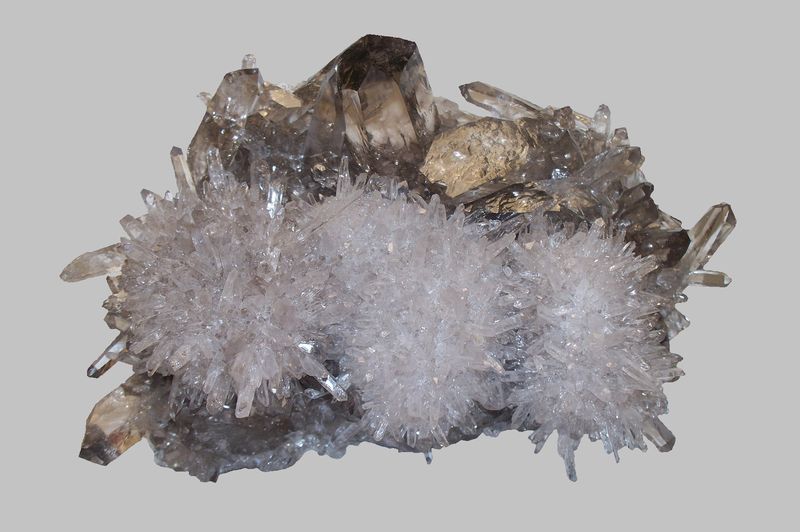
|
|
|
| Back to top |
|
 |
Elise

Joined: 22 Dec 2009
Posts: 243
Location: New York State



|
 Posted: Feb 24, 2015 21:03 Post subject: Re: Quartz, Natural and Synthetic Posted: Feb 24, 2015 21:03 Post subject: Re: Quartz, Natural and Synthetic |
|
|
| Jamison Brizendine wrote: | | My mother inquired if my specimen (the broken Guerrero), had won any awards. I explained to her that the quartz cases were non-competitive cases, but apparently if “Most scary!!” is an award, I guess it won that. Vlad told me that a lot of dealers (names withheld, but the majority whose names I had recognized) mentioned that they were “afraid”. |
Hi Jamison - I'm so glad you chimed in on this thread. Thank you so much for clarifying about the twins in the display and on the distorted one I have. I have seen synthetic Japan-law twins more than a year ago (and have been since waiting patiently for one which is "on order"...maybe still growing).
I'm perplexed by the reports of some people's reaction to the regrown/repaired specimen in the display - it seems unwarranted and hopefully the upcoming article will dispel these fears, as well as illuminate further this fascinating endeavor. The upcoming article was announced in the display materials, but I hope it will come as a welcome surprise to the majority of the R&M readership.
Gemologist John I. Koivula reminded me earlier today about an example of quartz re-growth in experiments dating back to 1908. This was published in a 1944 paper by Paul F. Kerr and F. Armstrong entitled "Early experiments in quartz growth through about 1940" (Bulletin of Geological Soc. of America, 54, Supplement 1, pp 1-4). In it is a picture showing a natural Japan-law twinned quartz crystal before and after 5 months of re-growth of its two broken terminations (also of its unbroken termination). This picture also appears in Kurt Nassau's book "Gems Made by Man" page 101. As with your specimen, the regrowth is visibly different in both clarity and form from the natural part.
Best wishes,
Elise
_________________
Elise Skalwold |
|
| Back to top |
|
 |
alfredo
Site Admin

Joined: 30 Jan 2008
Posts: 1011



|
 Posted: Feb 24, 2015 21:23 Post subject: Re: Quartz, Natural and Synthetic Posted: Feb 24, 2015 21:23 Post subject: Re: Quartz, Natural and Synthetic |
|
|
Jamison wrote: "... the “Japan Law Twins” are not actual Japan Law twins; they are an attempt to making one. So far he has been unsuccessful at getting the correct angle needed for it be a Japan-law. Our club has dubbed them “Vlad Twins”, but yes these are some of my favorites too. It is still unclear what conditions are needed for a Japan-Law twin to actually occur in nature, and Vlad has never seen a Japan-Law Twin actually grow in the autoclave."
Confirming what Jamison wrote above, I know a materials scientist in Japan who has spent many years researching synthesized quartz crystals and, from many many thousands examined, he has never seen a single Japan-law twin spontaneously generate in the autoclaves. He does occasionally manufacture true Japan-law twins, up to 5cm or so in size, but always starting with a tiny natural Japan-law twin, around 3mm or so in size, as the seed crystal.
|
|
| Back to top |
|
 |
Scott LaBorde
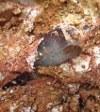
Joined: 14 Dec 2009
Posts: 104
Location: North Carolina



|
 Posted: Mar 10, 2015 13:07 Post subject: Re: Quartz, Natural and Synthetic Posted: Mar 10, 2015 13:07 Post subject: Re: Quartz, Natural and Synthetic |
|
|
For those interested here's a great video that talks about how synthetic quartz crystals are grown, along with many fine examples of the Russian specimens.
https://www.youtube.com/watch?v=PKQOSPwodWY
(link normalized by FMF)
_________________
Scott LaBorde |
|
| Back to top |
|
 |
Pete Richards
Site Admin
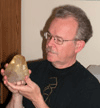
Joined: 29 Dec 2008
Posts: 843
Location: Northeast Ohio



|
 Posted: Mar 10, 2015 17:01 Post subject: Re: Quartz, Natural and Synthetic Posted: Mar 10, 2015 17:01 Post subject: Re: Quartz, Natural and Synthetic |
|
|
| alfredo wrote: | snip, and a bit of rewording...
A materials scientist in Japan has spent many years researching synthesized quartz crystals and, from many many thousands examined, he has never seen a single Japan-law twin spontaneously generate in the autoclaves. He does occasionally manufacture true Japan-law twins, up to 5cm or so in size, but always starting with a tiny natural Japan-law twin, around 3mm or so in size, as the seed crystal. |
Yes, this is exactly what would be expected. Twinning is one consequence of a sudden burst of crystal growth (nucleation) where high crystallization pressures lead to slight but crystallographically systematic "mistakes" in early crystal growth that we later call twins. In a synthetic growth environment, everything is tightly controlled, and the seed makes sure that saturation does not get too high. Regular parallel growth on the seed is to be expected. If one provides a Japan-law twinned seed, then regular growth should follow the established pattern and continue the twin. But spontaneous twinning is very unlikely in this environment.
_________________
Collecting and studying crystals with interesting habits, twinning, and epitaxy |
|
| Back to top |
|
 |
Elise

Joined: 22 Dec 2009
Posts: 243
Location: New York State



|
 Posted: May 26, 2015 11:38 Post subject: Re: Quartz, Natural and Synthetic Posted: May 26, 2015 11:38 Post subject: Re: Quartz, Natural and Synthetic |
|
|
| Pete Richards wrote: | | I have a quartz specimen that I treasure, made by Vlad. I treasure it because its basic symmetry is all wrong - it is a cube! Actually, I'm sure the symmetry is all right (alright?) because it is controlled by the structure. But the way the seed was cut allowed it to develop into a cube. Fun! |
Sharing Pete's enthusiasm for enigmas, here are two of the oriented and etched synthetic quartz cubes; one with the faces, piezoelectric and optical directions labeled. I showed these to Si and Ann Frazier last weekend and they were as fascinated by them as we are!
The optical axis "c" ( Z for piezoelectric) is perpendicular to the pinacoid (0001) faces with triangle etch pits. Axis "a" (X, or electrical axis) is perpendicular to the "c" and both trigonal (positive +X and negative -X) prism faces. Mechanical axis Y is perpendicular to both "c" and "a" axes and to the hexagonal prism "m" faces.
The cube on the left is rotated so the "m" face is facing front, while the cube on the right has the "m" face facing to the right(ish).The red and green arrows mark the rhombohedral faces and the blue one marks the trigonal bipyramid (as I understand it, the yellow arrow points to a contact point in the chamber).
| Description: |
| Synthetic Quartz (oriented and etched) |
|
| Viewed: |
46604 Time(s) |
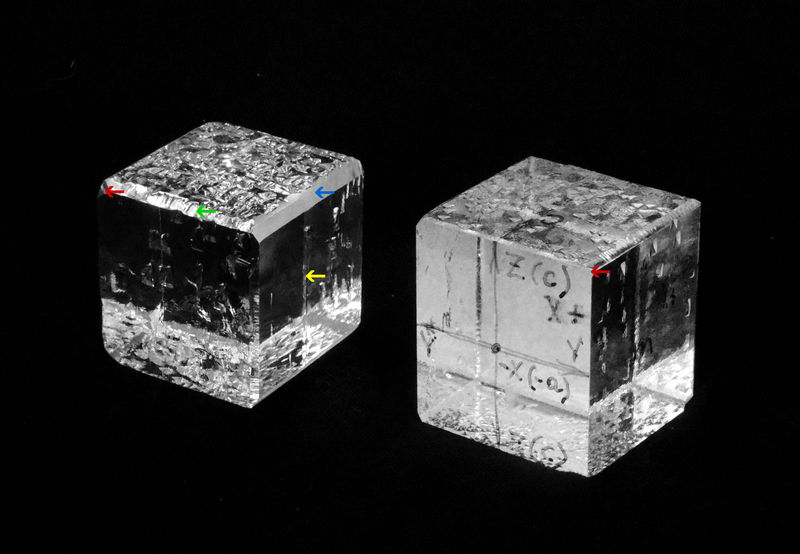
|
| Description: |
|
| Viewed: |
46555 Time(s) |
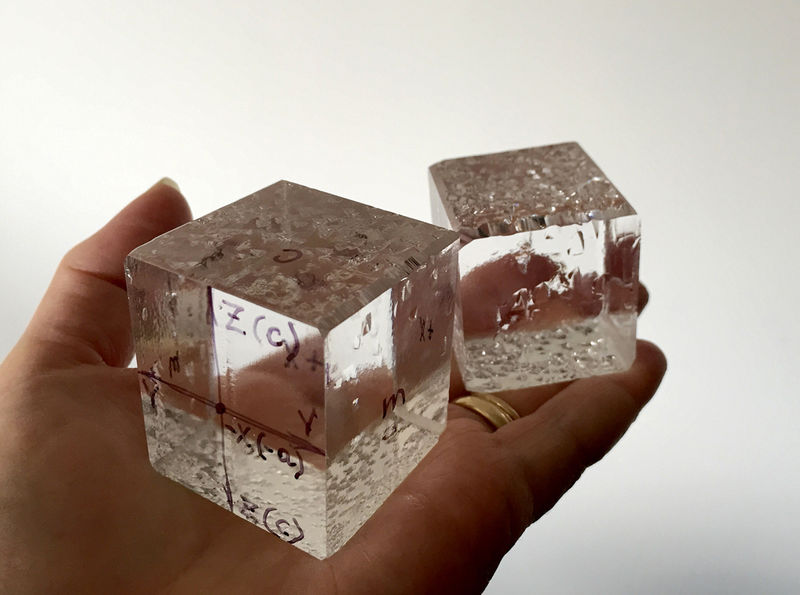
|
_________________
Elise Skalwold |
|
| Back to top |
|
 |
James Catmur
Site Admin

Joined: 14 Sep 2006
Posts: 1463
Location: Cambridge



|
 Posted: May 26, 2015 13:14 Post subject: Re: Quartz, Natural and Synthetic Posted: May 26, 2015 13:14 Post subject: Re: Quartz, Natural and Synthetic |
|
|
| Wow, great fun and really interesting. I can see why they liked them. Even though they are synthetic I could give them a home!
|
|
| Back to top |
|
 |
pierres-gemmes
Joined: 26 May 2015
Posts: 6
Location: Montpellier


|
 Posted: May 26, 2015 13:20 Post subject: Re: Quartz, Natural and Synthetic Posted: May 26, 2015 13:20 Post subject: Re: Quartz, Natural and Synthetic |
|
|
| It's very beautifull and squares are perfect. Congratulations ! :)
|
|
| Back to top |
|
 |
|





